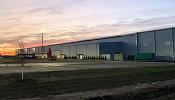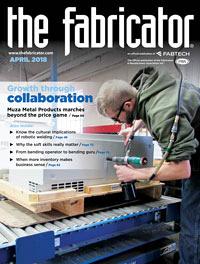- FMA
- The Fabricator
- FABTECH
- Canadian Metalworking
Categories
- Additive Manufacturing
- Aluminum Welding
- Arc Welding
- Assembly and Joining
- Automation and Robotics
- Bending and Forming
- Consumables
- Cutting and Weld Prep
- Electric Vehicles
- En Español
- Finishing
- Hydroforming
- Laser Cutting
- Laser Welding
- Machining
- Manufacturing Software
- Materials Handling
- Metals/Materials
- Oxyfuel Cutting
- Plasma Cutting
- Power Tools
- Punching and Other Holemaking
- Roll Forming
- Safety
- Sawing
- Shearing
- Shop Management
- Testing and Measuring
- Tube and Pipe Fabrication
- Tube and Pipe Production
- Waterjet Cutting
Industry Directory
Webcasts
Podcasts
FAB 40
Advertise
Subscribe
Account Login
Search
Lean manufacturing meets custom tow truck assembly
Custom tow truck maker transforms assembly and nearly doubles output
- March 30, 2018
- Article
- Assembly and Joining
Like most youngsters during the 1960s, long before video games and hand-held devices, I spent my summers atop a dirt pile playing with Tonka backhoes, low boys, and tow trucks. Most of us outgrow the dirt pile, but some kids never outgrow the love of heavy equipment.
For years I’ve had the privilege of helping companies become more competitive, and I’ve worked with a few manufacturers that make full-sized copies of the toys I used to play with. Such was the case last year when working with Fleet Sales West (FSW). Company Owner and President Donna Bookout-Coe also owns West Coast Towing Equipment and Golden West Towing Equipment, with a total of 50 employees among the three companies.
A builder of highly customized tow trucks, FSW was dealing with diminishing profits, delays in the supply chain, a lack of coordination between fabrication and assembly, a woeful lack of standardization, high levels of non-value-added activities, and imbalances in work flow caused by significant differences in labor content from unit to unit. The 15-person organization produced four or five trucks a month when it needed 10 a month to make ends meet. Worst of all, FSW had extremely high staff turnover.
I envisioned dirty, greasy, rusty tow trucks hauling broken and bent vehicles. Accepting Coe’s invitation to visit, I was surprised to find a substantially different environment. Looking more like a lodge than a manufacturing site, the building serves as a photogenic backdrop for each gleaming, freshly painted, chrome-embellished car carrier or tow truck as it awaits delivery to customers.
Having arrived early for my meeting with Coe, I was ushered into her office to wait. As I scanned the many photos on the wall, I began to recognize that this was no ordinary company or business owner. In one photo Coe stood side by side with President Reagan. In another she shared the stage with Oliver North. Another photo showed her standing with Bob Dole, and yet another with Rudy Giuliani. Before taking the reins of FSW, Coe had been a product safety and risk mitigation trainer and spokesperson for the towing industry nationally.
Coe described the company position as tenuous. While her sales team (led by her son Jim Walsh) had plenty of orders, customers were angry and staff members were demoralized. The shop just couldn’t meet production timelines and quality standards.
Walsh’s vision of highly custom truck builds is one of FSW’s key differentiators. It’s why customers keep coming back. Walsh was the energy and focus of the business in the beginning, and his vision helped the operation grow into what it is today.
Being flexible and responsive to customers was (and still is) a very good thing, but it also meant that no two truck orders were alike. This made creating a uniform build process an enormous challenge. The shop had an ever-growing backlog and continually failed to meet production goals. Worst of all, customers grew increasingly impatient and unhappy.
Coe’s long-term goal was for FSW to produce 12 trucks per month, without more overtime or hiring additional staff. The truth was, FSW wasn’t even close. Unable to crack the 10-truck-per-month break-even barrier, Coe considered moving the operation to Mexico or, worse yet, closing the business entirely.
As I toured the facility, I noticed that the truck-building team seemed to spend a lot of time walking back and forth among fabrication, the parts room, tool boxes, and hardware storage bins.

Figure 1
These mobile shadow boards provide assemblers with just the tools they need, no more and no less.
I watched one operator, bending uncomfortably over the side of a gray plastic tote, spend five minutes finding the wire harness he needed. I estimated that people spent about 30 percent of their day performing non-value-adding activities—walking, fetching, searching, and searching some more. The situation was ripe for a lean transformation.
Improvement Starts
We began by value-stream-mapping the entire process, timing each step. We found it took one person a full month (160 hours) to build and test a truck. We observed a few technicians walking back and forth, back and forth, and back and forth again across the floor; all that added up to seven miles per day. The average person can comfortably walk 2.5 miles per hour. For a team of eight people working 250 days, this equates to 5,000 miles of walking per year. To put this in perspective, it would take one full-time employee, working one shift five days a week, an entire year to walk this distance and accomplish nothing else. Here’s another way to look at it: About 12.5 percent of the company’s direct labor expenses went into nothing more than paying people to walk from one place to another.
If we removed the walking, waiting, and other non-value-added time, we estimated that it would take only about 80 hours to assemble a truck. To get started, we divided an assembler’s time into five daily buckets of work, began developing standard work, and assigned two people to each truck. We were off and running.
Soon we found that each assembler had toolboxes stuffed with many tools that they just didn’t need. We identified what assemblers regularly used, designed portable shadow boards, and gave them the tools they needed, no more and no less (see Figure 1).
We identified the components needed for each day’s build and reorganized them on the bill of material as “Day 1,” “Day 2,” “Day 3,” and so forth. Rather than spending time searching for items, employees fabricated or pulled components and staged them on carts according to which day they would be installed on the truck. We labeled each cart with the truck number and build day (see Figure 2).
The fabrication team and stock room staff ensure parts are produced on demand. The stock room team stages carts at least one day ahead of each assembly team. No longer are parts produced in large batches and stored for long periods. The team working on a Day 2 cart can see the Day 3 cart waiting for them. This allows everyone to mentally prepare for the next day.
To make this “one-cart flow” a reality, stock room personnel needed to have everything on hand, but initially they couldn’t make it happen because of part shortages. They solved this problem by identifying a more accurate way to determine stock levels and by adopting a kanban (signal card) replenishment system (see Figure 3).
The stock room staff no longer relies on monthly cycle counts to verify quantities. Limited vendor-managed inventory (for nuts and bolts) also frees up the staff to focus on higher-level improvements.
FSW is a custom shop, so considering the high degree of variation in truck build time (see Figure 4), it was little wonder the assembly team spent at least 20 minutes a day huddled around a whiteboard. They needed estimates from each assembly tech about where the truck stood in assembly. Was the truck 60 percent complete? How about 95 percent? It really was just a guessing game. When customers called, no one could tell them exactly when the trucks would be ready.
Moreover, 20 minutes every day adds up over time. The 20 minutes spent by eight people in this daily guessing-game huddle amounted to 160 minutes of downtime per day. That’s 667 hours per year spent on non-value-added activity. In all that time, the company could have built roughly eight more trucks a year.
To remedy this, we defined the actual time required for each level of customization, and we categorized it into units of work: a truck requiring 80 hours is one unit of work, a truck requiring 160 hours is two units of work. This unit approach provided an accurate picture of capacities and takt time (output rhythm based on available time and demand).
We eliminated the daily huddles and replaced them with a daily gemba walk, a Japanese term meaning “go to where the work is happening.” Instead of relying on drawn-out “best-guess” meetings, managers went to where the work was happening and saw for themselves where things stood.
Slowly, the monthly build quantities improved: five trucks per month, then six, then seven. Each month broke a new record, and with every new record came a celebration barbeque for the entire team.
Eventually the company hit its break-even goal of 10 trucks per month. After breaking that barrier, though, improvement lulled, and company-wide meetings ensued to discuss the issues. What was holding FSW back from that elusive 12-truck goal?
What seemed to be missing was a uniform assembly method. While each day’s assembly components now were being staged on carts at each build station, each assembly team still had great latitude in determining their preferred build sequence, method, and assembly process. Although the situation had improved greatly, variation in assembly time remained.
To remedy this, FSW documented, photographed, and even video-recorded what was deemed the best practice for each stage of assembly. Subsequent training ensured that everyone understood how to perform those best practices in the same way.
The documents, complete with step-by-step instructions and accompanying color photos, were initially printed. But after some wordsmithing and polishing, the instructions (what FSW calls build modules) were loaded onto tablets supplied to each workstation. This not only saves paper and ink but allows managers to update the instructions as needed (see Figure 5).
The People
Positive changes cannot happen without good people, and the leaders at FSW have certainly taken this to heart. They identified talent, made changes when necessary, and gave top performers the opportunity to make a difference.
Several months into its improvement initiative, FSW hired Greg Gifford as vice president of operations. Gifford provided a clear vision. With endless patience, he identified everyone’s strengths and teamed people up in a way that allowed everybody to perform at their best.
Assembly Technician Nick Erma’s story perhaps describes this best. As Gifford explained, “There was an immediate need to develop best practices and identify someone who could serve as an in-house training coordinator. At 21 years old, Nick was not our most senior employee, but he was highly motivated and willing to help document standard operating procedures, and then transfer that critical knowledge to the other members of the team.”

Figure 3
These laser cut and formed parts from a local metal fabricator are replenished with a simple kanban system. An empty bin signals the purchasing department to place another order with the fabricator.
Erma received some specialized training from the Oregon Manufacturing Extension Partnership (OMEP), including train-the-trainer coaching. “This helped him understand how to effectively transfer knowledge while displaying respect, empathy, and patience during the critical training period.
“It has been a remarkable and satisfying experience to watch Nick’s personal development,” Gifford continued. “His management, communication, and team-building skills have matured significantly during this process. These skills proved valuable not only for Nick but also for the entire company. Nick has recently accepted the position of shop foreman.”
The culture change and employee buy-in weren’t always easy, especially for some. A few long-term employees resisted. “We conducted numerous staff meetings to help them understand to embrace new thinking and modify old behaviors,” Gifford said. “Some adapted successfully, while others were less willing to engage. Difficult decisions became obvious and necessary. As painful as it was, a few staff members were encouraged to seek other opportunities. And because of the enormous backlog of orders, we had to avoid the temptation to simply fill [an empty position] with the first available technician we interviewed. Instead, we took our time to focus not only on core skills, but also on attitude and emotional fit with the rest of the team.”
That said, managers also have promoted from within. “FSW now has a strong bench [of talent],” Gifford said, adding that besides Erma’s promotion to shop foreman, the company has promoted another individual to lead expeditor.
Thanks to the financial benefits of lean, managers have reevaluated benefits and wages. They recently added a 401(k) program and launched a new wage structure and comprehensive gainsharing program that provides higher wages and bonuses when employees meet key performance indicators.
The gainsharing program is based on a combination of cost metrics, on-time delivery performance, and, perhaps most important, peer-to-peer evaluations (see Figure 6). As Gifford explained, “Each team member is offered real-time feedback from the entire team regarding critical behaviors, such as dependability, quality, enthusiasm, helpfulness, attitude, adherence to 5S principles, safety, and technical skill.”
Supplier Strategies
While FSW does perform minor fabrication, primarily welding and cutting, the company outsources most of its work to local sheet metal fabrication vendors. Without reliable suppliers, FSW wouldn’t be as successful as it is today.
In fact, one FSW employee worked so closely with one fabricator, he embedded himself within the fabrication operation. “That employee worked shoulder to shoulder with the supplier team members to ensure product quality and delivery fulfilled expectations,” Gifford said.The FSW employee learned about the fabricator’s operations and challenges, then talked about specific FSW requirements: sheet metal parts that were cut, bent, welded, painted, and delivered in the right amount and at the right time, almost always in small lot sizes.
“By selecting vendors and suppliers who understand lean thinking, and in some cases educating them about our objectives, we have helped them be more responsive. Having them make smaller lot sizes was a challenge at first, but they have applied 5S and setup reduction techniques to help minimize the cost of lower volumes.

Figure 4
An assembler works on a recently arrived tow truck chassis. No two trucks leaving the facility are exactly alike.
“We had to be clear that we cannot be successful without their active participation,” Gifford continued. “Our fabrication partners are more like an extension of our company than just a supplier.”
Next Steps
After a full year of work, the team finally broke through the 12-truck finish line, and they show no sign of slowing down. The latest goal is to reach 15 trucks a month.
So what’s next? “As with any improvement initiative, it’s a bit like peeling an onion,” Gifford said. “As you peel back one layer, another layer of improvement exposes itself. We still use two-person teams to stall-build trucks from start to finish. The next logical step is to explore more of an assembly line process. We also discussed moving improvement upstream into our sales and administrative processes. And we need to expand the learning gained [at our facility] in Woodburn [Ore.] to our two other facilities in California.”
The financial results speak for themselves. FSW went from producing four to five trucks a month to 12—a 160 percent increase. Using an average truck sale price of $150,000, this equates to $1.125 million more revenue produced per month, or an additional $13 million per year. That’s not bad for a team of 15 employees. By the look of things, FSW is just getting started.
Gary Conner is a senior consultant with the Oregon Manufacturing Extension Partnership (OMEP), 7650 SW Beveland St., Suite 170, Portland, OR 97223, 503-580-1156, www.omep.org. He has spent more than 25 years helping organizations implement lean techniques. OMEP is one of 51 manufacturing extension partnership (MEP) centers in the U.S. MEPs are chartered by the Commerce Department to help small- to medium-sized manufacturers grow their business to become more competitive. Conner thanks Greg Gifford, vice president of operations at Fleet Sales West, for his contribution to this article.
Photos courtesy of Fleet Sales West, www.fleet saleswest.com.
About the Author
subscribe now

The Fabricator is North America's leading magazine for the metal forming and fabricating industry. The magazine delivers the news, technical articles, and case histories that enable fabricators to do their jobs more efficiently. The Fabricator has served the industry since 1970.
start your free subscription- Stay connected from anywhere

Easily access valuable industry resources now with full access to the digital edition of The Fabricator.

Easily access valuable industry resources now with full access to the digital edition of The Welder.

Easily access valuable industry resources now with full access to the digital edition of The Tube and Pipe Journal.
- Podcasting
- Podcast:
- The Fabricator Podcast
- Published:
- 05/07/2024
- Running Time:
- 67:38
Patrick Brunken, VP of Addison Machine Engineering, joins The Fabricator Podcast to talk about the tube and pipe...
- Trending Articles
White House considers China tariff increases on materials

A deep dive into a bleeding-edge automation strategy in metal fabrication

Majestic Steel Arkansas fully operational

A visit to Automate 2024 reveals the future might be now

Rivian to expand Illinois facility to manufacture midsized SUV

- Industry Events
Laser Welding Certificate Course
- May 7 - August 6, 2024
- Farmington Hills, IL
World-Class Roll Forming Workshop
- June 5 - 6, 2024
- Louisville, KY
Advanced Laser Application Workshop
- June 25 - 27, 2024
- Novi, MI
Precision Press Brake Certificate Course
- July 31 - August 1, 2024
- Elgin,





























